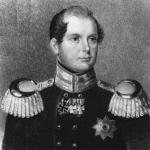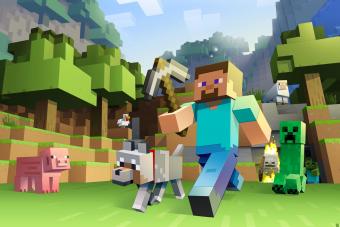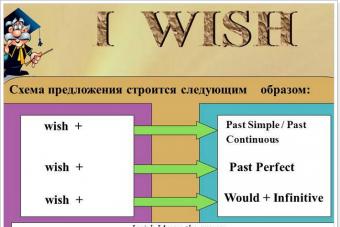1. Add hydrochloric acid solution. Gas is released in a test tube with sodium carbonate.
The remaining substances are dissolved in water and
phenolphthalein is added to the resulting solutions.
In one test tube with alkali, the solution turns pink.
To the remaining solutions, add a solution of nit-
rata of silver. In a test tube with magnesium chloride,
a white precipitate forms.
To the remaining solution, add concentrated
sulfuric acid and a piece of copper. Heating
vaem. A brown gas is released, which is evidence
indicates the presence of sodium nitrate in the test tube:
2. Add hydrochloric solution to all substances
acids. In a test tube with carbonate,
carbon dioxide:
Gas is released in a test tube with sodium sulfide
with the smell of rotten eggs - H2S.
After dissolving the remaining substances in water
add sodium sulfate solution.
In a test tube with strontium nitrate,
white precipitate.
To the remaining solution, add a solution of chlorine
barium rida. A white precipitate of sulfate is formed
barium:
3. Add a solution to the given substance
barium chloride. A white precipitate is formed, which
indicates the presence of a sulfate ion.
When interacting with alkali or hydroxy-
ammonium hydroxide white precipitate
aluminum:
4. Sodium chloride colors the flame of the burner in
yellow.
Strontium chloride is determined by reaction with sul-
ammonium fatom, as a result of which
white precipitate:
We prove aluminum chloride by reaction with hydro-
sodium oxide
5. Dissolve the crystals in water and add
NaOH solution. Green and brown precipitates are formed. 
If iron (II) sulfate contained Fe3+, then in
green sediment will have streaks or spots of brown
colors.
6. In water containing MgSO4, add dis-
creat Na2CO3. A white precipitate forms.
Mg2+ ions cause a constant hardness
water bone. This water can be softened by adding
sodium carbonate solution, since this
binding of Mg2+ ions.
In water containing Ca (HCO3) 2, add:
Na2CO3 solution, milk of lime, that is, saturated
brine solution of Ca(OH)2; boil it. Formed
white precipitate. 
The presence of Ca(HCO3)2 causes the time
water hardness. This water can be softened
by adding milk of lime, soda or boiling
value, since all these processes are accompanied by
the formation of CaCO3.
7.
Practical work Grade 7
|
World Maps |
Country maps |
Continent maps |
general geographic |
Thematic |
small scale |
Medium scale |
large scale |
|
Physical map of the world The structure of the earth's crust |
Physical map of Russia |
Australia |
The structure of the earth's crust Climate map of the world |
Physical map of the world mother cards |
Ulyanovsk region |
Topographic maps of the Ulyanovsk region |
Practical work 2
Similarities:
Young mountains in the west, old ones in the east
In the center of the continents - plains
Difference features:
In S. America, there are fewer lowlands in area, and more in South America
In South America, there is more contrast (mountains - lowlands).
Practical work 3, 4
|
Signs for comparison |
equatorial belt africa |
subequatorial |
|
Around the equator |
Between the tropic and the equator |
|
|
air masses |
||
|
1000 - 2000 mm |
In summer - 1500-2000 computers (wet) Winter - 250 mm TVM (dry) |
|
|
Floods, high humidity - negative. |
Winter droughts - negative. |
Practical work 5
Practical work 6
|
Population density, person/km² |
|||
|
S. America |
|||
|
South America |
|||
|
Australia |
|||
Practical work 7
2. Eskimos, Evenks, Indians
Practical work 8
Practical work 9
O. Madagascar
Lakes. Most are of tectonic and volcanic origin. Of the large lakes stand out: Alautra, Mantasua
View document content
"Practical work Grade 7"
Practical work Grade 7
Grouping textbook and atlas maps according to different criteria
Give examples in the atlas of the following maps:
| World Maps | Country maps | Continent maps | general geographic | Thematic | small scale | Medium scale | large scale |
| Physical map of the world The structure of the earth's crust | Physical map of Russia | Australia | Topographic maps of the Ulyanovsk region | The structure of the earth's crust Climate map of the world | Physical map of the world mother cards | Ulyanovsk region | Topographic maps of the Ulyanovsk region |
Practical work 2
Reading maps, space and aerial photographs of the continents. Description on the relief map of one of the continents. Comparison of the relief of two continents, identification of the causes of similarities and differences.
1. Description of the relief of the African continent.
In Africa, plains predominate, because. at the base of the mainland lies a platform.
In the north of the mainland are the Atlas mountains, in the south the Cape and Drakon.
2. Comparison of the relief of North America with South America.
Similarities:
Young mountains in the west, old ones in the east
Plains in the center of the continents
Difference features:
In S. America, there are fewer lowlands in area, and more in South America
The belt of mountains in S. America is wide, in South America it is wider
In South America, there is more contrast (mountains - lowlands).
Practical work 3, 4
| Signs for comparison | equatorial belt africa | subequatorial |
| Around the equator | Between the tropic and the equator |
|
| air masses | ||
| Annual amount of precipitation, their regime; reasons for differences | 1000 – 2000 mm | In summer - 1500-2000 computers (wet) Winter - 250 mm TVM (dry) |
| The impact of climate on the life of the population | Floods, high humidity – negative. Growing tropical crops, large yields pos. | Winter droughts - negative. |
Practical work 5
Analysis of maps of anthropogenic landscapes. Identification of continents with the largest areas of such landscapes.
1m. Eurasia, 2. Africa, 3. South America, 4. North America, 5. Australia, 6. Antarctica (number of population)
Practical work 6
Comparative description of the number, population density of the continents
| Population, million people | Population density, person/km² |
|||
| S. America | ||||
| South America | ||||
| Australia | ||||
Practical work 7
Modeling on the contour map of the placement of the largest ethnic groups and small peoples, as well as large cities
1. Chinese, Arabs, Hindustanis, Americans, Bengalis, Brazilians, Russians, Mexicans, Japanese.
2. Eskimos, Evenks, Indians
Practical work 8
Identification and reflection on the contour map of the transport, commercial, raw material, recreational and other functions of one of the oceans.
Practical work 9
Description on maps and other sources of information, features of the GP, nature and population of one of the large islands
O. Madagascar
1. GP. Located in the western part of the Indian Ocean. It is separated from Africa by the Mozambique Channel.
2. Relief. In the central part it is elevated 1000 m, along the lowland coast 200 m.
3. Minerals: titanium, copper, lead, zinc. Especially significant are the reserves of graphite and mica, in which Madagascar ranks first in Africa and, respectively, fourth and second in the world.
4. Subevatorial (humid), tropical (dry). The amount of precipitation is 1000-1500 mm per year.
t° - 25°- 30°. Precipitation is mainly in summer.
5. Rivers. Many Large - Manguru, Mananara, Bemarivu
Lakes. Most are of tectonic and volcanic origin. Of the large lakes stand out: Alautra, Mantasua
6. Natural areas: evergreen forests, tropical deserts. There are no large mammals, except for imported domestic animals, but lemurs and small insectivorous animals are diverse here, among which tenrecs and geckos are endemic.
7. Malagasy. Agriculture. Catch a fish
"Simple" table.
In this work, students practice methods for creating and using simple tables, as well as text alignment.
Students are shown using a table as a frame around one or more paragraphs. To shift text in a table cell, use the keysCTL+ Tab. Pay attention to the alignment of the paragraph in the center relative to the borders
Insurance of property of residents of the city of Uryupinsk
|
p/p |
Client code |
Surname, name, patronymic of the client |
Property name |
Insurance start date |
End date of insurance (rub.) |
Sum insured |
The amount of the monthly installment in (rub.) |
|
Home ownership |
|||||||
|
Petrov V.G. |
home ownership | ||||||
|
Romanova K.O. | |||||||
|
Volkova E.I. | |||||||
|
Country cottages |
|||||||
|
Gorin V.V. |
Country cottage | ||||||
|
Kotikov N.N. | |||||||
|
Petrova E.N. | |||||||
|
Yashkina S.S. | |||||||
|
Cars |
|||||||
|
Sergeeva M.A. |
car Zhiguli | ||||||
|
Popov G.N. | |||||||
|
Ivanova S.P. |
car Moskvich | ||||||
|
Uvarov S.A. |
car Volga | ||||||
Practical work No. 7
"Complicated Table"
In this activity, students practice methods for creating and using simple tables, as well as text alignment, using lists, merging and filling cells.
Students are shown using a table as a frame around one or more paragraphs (Form code by...). To shift text in a table cell, use the keysCTL+ Tab. Pay attention to the alignment of the paragraph (Medical documentation...) in the center relative to the borders. Particular attention is paid to the use of an inextensible space when justifying a paragraph in width, but without stretching the spaces between words. As an example, you can consider any document with an inscription below: the position and last name of the person, when the position should be pressed to the left edge, and the last name to the right. Alternatively, you can use a table with one row and two columns and transparent borders.
Each student is given a printed version of the assignment. He needs to dial it exactly according to the sample.
Pay attention to the size of the top table, the use of lists in the bottom table horizontally and vertically, alignment in cells, the same size of columns, center alignment of the entire table, a thicker border around the table, and also do not forget about the work requirements already mentioned. Be sure to include non-printable characters for a quality check of your work. Otherwise, with the apparent visual correspondence of the student's work with the sample, it may not be correctly performed.
All padding, protrusions and borders are in multiples of 0.5 cm for ease of measurement and execution.
|
ODUC form code ٱٱٱٱٱٱ Institution code ٱٱٱٱٱ |
__________________________
name of institution
Practical work number 1.
Designation on the contour map of the continents and oceans.
Progress:
Using the text of the textbook and maps of the atlas, on the contour map, in black, sign the names of the continents, indicate their area and sign the names of their discoverers, and in blue - the names of the oceans.
Practical work number 2.
Solving problems on a geographical map.
Progress:
Using a physical map of the world (pp. 2 - 3) or a globe, fill in the table:
Option 1.
| geographical feature | Geographical coordinates | Direction from Moscow | Distance from Moscow | Altitude |
| London Volk. kilimanjaro Cape Chelyuskin South Pole |
Option 2.
| geographical feature | Geographical coordinates | Direction from Moscow | Distance from Moscow | Altitude |
| New Orleans North Pole Aconcagua cape byron |
Practical work number 3.
Determining the direction of movement of lithospheric plates on the map and predicting their position in the distant future.
Progress:
The work is carried out according to the following plan:
Using the map of the atlas "The structure of the earth's crust", determine
1. in what direction and at what speed does each lithospheric plate move.
2. Name the regions of the Earth where the divergence occurs, and where the collision (compression) of lithospheric plates occurs.
3. What forms of relief are formed at the places of divergence and collision of lithospheric plates?
4. Imagine how the continents and oceans will be located in many millions of years.
5. Make a schematic drawing of the location of the continents and oceans in the distant future.
Practical work number 4.
Identification on the map of coasts and shelf as special territorial-aquatic natural complexes.
Progress:
Using the physical map of the world (atlas, pp. 2 - 3) and the list of geographical nomenclature (see below), on the contour map of the world, shade the shelf zone of the World Ocean in blue (shelf - continental shelf to a depth of 200 m), sign the names of the oceans in blue , the largest seas, bays and straits, and in black - the names of the continents, the largest islands and peninsulas of the Earth.
List of geographical nomenclature:
Oceans:
Atlantic;
Indian;
Arctic;
Seas:
Baltic;
Beringovo;
East Siberian;
Mediterranean;
Tasmanovo;
Philippine;
South China;
bays:
Bengal;
Big Australian;
Guinean;
Hudson;
Mexican;
Straits:
Beringov;
Gibraltar;
Magellan;
Mozambican;
Islands:
Great Britain;
Greenland;
Iceland;
Kalimantan;
Madagascar;
New Guinea;
New Zealand;
Japanese;
Peninsulas:
Arabian;
Hindustan;
Kamchatka
Practical work number 5.
Designation on the contour map of areas of high population density, directions of migration in the past and current population movements.
Progress:
Using a political map of the world, on a contour map, mark the boundaries of the 10 largest countries in the world by population and sign their names;
Using the map “Peoples and population density of the world” on pages 12-13 of the atlas, shade the main areas of population distribution:
1. Eastern, Southeast and South Asia, Central and Southern Europe and the eastern United States;
2. Use blue arrows to indicate the main routes of population migration in the 16th - early 20th centuries: from Europe to North and South America, Australia and South Africa, from Africa to North and South America;
3. Use red arrows to indicate the paths of modern population migration: from the CIS countries to Russia, from Russia and Eastern Europe to Western Europe, from East Asia and Mexico to the USA, from North Africa and Southwest Asia (Middle East) - to the countries of Western Europe;
4. Draw a conclusion about the distribution of the world's population and changes in the direction of migration.
Practical work number 6.
Designation on the contour map of the names of the objects under study and the determination of the geographical coordinates of the extreme points.
Progress:
When studying the topic “Geographical position of Africa”, using the physical map of Africa (atlas, p. 14), on the contour map of Africa:
Mark the equator in red, the zero (Greenwich) meridian in blue, the North and South tropics in yellow;
Determine the length of Africa from north to south along 20o E. and from west to east along the equator and along 20o N;
Sign the names of the following geographical features:
oceans: Atlantic and Indian;
seas: Mediterranean and Red;
bays: Guinea and Aden;
straits: Gibraltar, Bab el-Mandeb, and Mozambique;
islands: Canary, Comoros, Madagascar and Zanzibar;
peninsula: Somalia;
extreme points: Cape Ben Secca (Ras Engel, El Abyad), Cape Agulhas, Cape Almadi, Cape Ras Hafun;
channel: Suez.
Determine the coordinates of the extreme points of Africa.
Practical work number 7.
Designation on the contour map of large landforms and mineral deposits.
Progress.
Mark on the contour map:
Plains, East African Plateau;
mountains: Atlas, Draconian, Ethiopian Highlands;
the highest point of the mainland: Mount Kilimanjaro (5895 m);
the lowest point of the mainland: the level of Lake Assal (-157 m).
Practical work number 8.
Determining the types of African climates from climatograms.
Progress:
According to the climatograms given in the atlas (p. 15), determine the type of climate in the cities of Addis Ababa, Algeria, Wallen and Debunja, substantiating your answer based on the annual variation in air temperature and precipitation.
Practical work number 9.
Make a description of the humid equatorial forests of Africa.
Progress:
Using atlases, a textbook, compose a story about the humid equatorial forests.
Plan:
Geographic location of the zone.
Climatic conditions.
Soils.
Vegetation.
Animal world.
Describing the natural area, reveal the relationship between the components of nature.
Practical work number 10.
Compilation of maps and other sources of knowledge describing the nature, population and economic activities of one of the African countries.
Progress:
The work is carried out in the form of a report, abstract, essay according to a standard plan:
Plan of the physical and geographical characteristics of the country:
The name of the country and its capital;
Physical and geographical position of the country:
a) the position of the country on the mainland;
b) the area of the territory;
c) with which countries and where it borders;
d) the position of the country in relation to the seas and oceans surrounding it;
d) natural areas;
e) dominant soils;
4. Population and its economic activity:
b) the dominant peoples;
c) the largest cities;
Practical work number 11.
Comparison of the geographic location of Australia and Africa.
Progress:
| Plan | similarities | Features of difference |
|
| Australia | Africa |
||
| 1. The size of the continents | |||
|
| |||
|
| |||
|
| |||
| 5. The nature of the coastline | |||
|
| |||
| 7. Conclusion | |||
Practical work number 12.
Substantiation of the reasons for the modern distribution of the indigenous population of Australia.
Progress:
The work is carried out in the form of an essay according to a standard plan:
Natural features of the country:
a) features of the structure of the earth's crust, the main landforms and minerals;
b) characteristic features of the climate (climatic zones, average temperatures in January and July, annual precipitation and their seasonality);
c) inland waters (largest rivers and lakes, their characteristic features);
d) natural areas;
e) dominant soils;
f) typical representatives of flora and fauna;
2. Population and its economic activity:
a) the number and location of the population;
b) the dominant peoples;
c) the largest cities;
d) what minerals are mined;
e) leading industries;
f) the main agricultural crops and livestock sectors;
g) the impact of human economic activity on the natural environment.
Practical work number 13.
Comparison of the geographical location of South America and Africa.
Progress:
Using the maps of the atlas, fill in the table "Comparison of the geographic location of Australia and Africa":
| Plan | similarities | Features of difference |
|
| South America | Africa |
||
| 1. The size of the continents | |||
| 2. The position of the continents relative to the equator and the prime meridian | |||
| 3. In which hemispheres are | |||
| 4. Oceans washing the shores of the continents | |||
| 5. The nature of the coastline | |||
| 6. Position relative to other continents | |||
| 7. Conclusion | |||
Practical work number 14.
Comparison of major river systems in Africa and South America.
Progress :
Using the maps of the atlas, the textbook test and other literature, fill in the table (the work is done according to the options):
| Plan | similarities | Features of difference |
|
| Africa river | South American river |
||
| Position on the mainland | |||
| Which ocean basin does it belong to? | |||
| Pool area | |||
| Location of the source and its coordinates | |||
| View of the mouth and its coordinates | |||
| Main river length | |||
| Current direction | |||
| The nature of the flow | |||
| Feeding the river | |||
| River mode | |||
| The largest left tributaries | |||
| Major right tributaries | |||
| Countries located in the river basin | |||
| Largest cities | |||
| Man's use of the river | |||
Option 1.Comparison of Congo and Parana.
Option 2.Comparison of the Nile and the Amazon.
Practical work number 15.
Designation on the contour map of the countries of South America and their capitals.
Progress:
Using the atlas (pp. 10 - 11), mark on the outline map of South America: Argentina, Bolivia, Brazil, Venezuela, Guyana, Guiana (fr.), Colombia, Panama, Paraguay, Peru, Suriname, Trinidad and Tobago, Uruguay, Falkland islands (brit.), Chile, Ecuador and sign the names of their capitals (administrative centers).
Color in black the colonial possessions of France and Great Britain.
Color green for landlocked countries.
Color in red a country located on two continents.
Practical work No. 16.
The image on the contour map of the shelf zones of the oceans.
Progress:
Mark the oceans, sign their name.
Mark the shelves in blue.
Mark in red the routes of scientific, industrial, recreational expeditions of one of the (selected) oceans.
Conventional signs show the types of economic activities of the population in the ocean.
Practical work number 17.
Comparison of the nature of the Arctic and Antarctic
During the classes:
Fill the table:
| Plan | similarities | Features of difference |
|
| Arctic | Antarctic |
||
| 1. Features of the geographical location | |||
| 2. The nature of the underlying surface | |||
| 3. Characteristic features of the climate | |||
| 4. Features of the animal and plant world | |||
| 5. Conclusion | |||
Protection of projects for the practical use of Antarctica or the Arctic Ocean in various fields of human activity.
Practical work number 18.
Comparison of the climate of individual parts of the mainland located in the same climatic zone.
Progress:
Using the maps of the atlas, fill in the table and draw a conclusion about the differences in the climate of individual parts of the mainland located in the same climatic zone:
Option 1.Comparison of the climates of the Florida Peninsula and the California Peninsula .
| Territory | Geographical position | climate zone | Climate type | Average temperature ( about FROM) | Annual precipitation | Precipitation regime |
|
| January | July | ||||||
| Florida | |||||||
| California | |||||||
Option 2.Comparison of the climate of the Alaska Peninsula and the Labrador Peninsula .
| Territory | Geographical position | climate zone | Climate type | Average temperature ( about FROM) | Annual precipitation | Precipitation regime |
|
| January | July | ||||||
| Alaska Peninsula | |||||||
| Peninsula Labrador | |||||||
Practical work number 19.
Drawing up a project of a possible trip to the countries of North America.
Creative work, presented in the form: (one thing)
computer presentation
Booklet
Works.
A description of modern landscapes and differences in the nature of the development of the territory along the line is obligatory.
Practical work number 20.
Comparison of natural zones along the 40th parallel in Eurasia and North America, identification of the causes of similarities and differences in the alternation of natural zones.
Progress:
Option 1.
Using atlas maps:
3) Enter the results of the work in the table:
| natural areas | similarities | Features of difference |
|
| in Eurasia | in North America |
||
Option 2.
Practical work number 21.
Comparison of natural zones along the 40th parallel in Eurasia and North America, identification of the causes of similarities and differences in the alternation of natural zones.
Progress:
Option 1.
Using atlas maps:
1) write down all the natural zones of Eurasia and North America from west to east along 40 ° N;
2) Determine the similarities and differences in the natural components of natural zones (average temperature in January and July, annual precipitation and their seasonality, inland waters, soils, flora and fauna) and their location on the territory of the continents;
3) Enter the results of the work in the table:
natural areas
similarities
Features of difference
in Eurasia
in North America
4) Make a conclusion about the reasons for the diversity of natural zones and the nature of their location on the continents.
Option 2.
Using the maps of the atlas, on the contour map of Eurasia, mark and sign the names of all natural zones located at 40 ° N with different colors. and answer the following questions:
1) What natural zones of Eurasia at the 40th parallel are absent at the same latitude in North America?
2) What are the natural zones of North America at 40 ° N.L. absent on the same parallel in Eurasia?
3) How does the location of natural zones differ in Eurasia and North America? What are the main reasons for these differences?
Practical work number 22.
Drawing on the contour map of the largest countries of Eurasia and their capitals.
Progress:
Using the political map of the world (atlas, pp. 10 - 11):
1) mark the borders and sign the names of Bangladesh, Great Britain, Vietnam, Germany, India, Indonesia, Iran, Italy, Kazakhstan, China, Mongolia, Pakistan, Russia, Saudi Arabia, Turkey, Ukraine, Philippines, France, Japan;
2) sign the names of the capitals of these countries;
3) Color in red the territory of the largest country in terms of area, and in yellow - the largest in terms of population.
Practical work number 23.
Compilation of a "catalog" of countries in Europe and Asia.
During the classes:
Using various sources of information, compile a “catalogue” of the countries of Eurasia, noting the most important statistics of the countries listed:
· the name of the country;
· state flag;
state structure;
· the area of the land;
· population;
the capital.
Enter data on countries in the table:
| Country | State flag | State structure | The area of the land (thousand km 2 ) | Population (million people) | Capital |
Option 1. Asian countries.
Option 2. European countries.
Practical work number 24.
Compilation of the simplest maps of the placement of cultural and historical centers of Europe and Asia.
Progress:
Using the maps of the atlas and additional literature, on the contour map of Europe or Asia (depending on the option), mark at least 10 most important historical and cultural centers of different countries of these continents with conventional signs and sign the names of countries and marked centers.
Option 1. Historical and cultural centers of Europe.
Option 2. Historical and cultural centers of Asia.
Practical work number 25.
Work on the ground to identify the components of natural complexes and draw up the simplest plan of the area.
Progress:
1) During the tour, conduct route shooting and draw up a plan of the area.
2) In your notebook, give a brief description of the route of movement, indicating the observed changes in the nature of the relief, inland waters, soils and vegetation.
Solutions for a notebook for practical work and individual assignments in geography for grade 7 authors A.N. Vitchenko, G.G. Butt, N.G. Stankevich Elementary course in geography.
Dear seventh graders!
Here is a geography workbook for grade 7. The implementation of the proposed tasks will help to better understand the program material. Tasks have varying degrees of difficulty. Many of them not only require knowledge of the textbook material, but also involve the analysis of atlas maps. Not all tasks are mandatory, their number and level of difficulty are determined by the teacher.
This guide is divided into two sections. The first contains materials for independent work in the study of major topics. After some topics, you will find additional blank pages. They are intended for assignments that can be compiled by the teacher and offered to you to complete and control knowledge.
The second section contains materials and instructions for performing programmatic practical work, as well as the necessary contour maps. When performing practical work, pay attention to the first stage. It is called “Knowledge Update” and is an important part of every practical work. When you complete this stage, you will be able to restore in your memory the knowledge that will be necessary for the successful completion of all the work. These tasks (on the recommendation of the teacher) can be completed in advance.
CONTENTS TO THE PRINTED NOTEBOOK ON GEOGRAPHY GRADE 7 VITCHENKO
Topic 1. Atmosphere. Weather and climate 4
Topic 2. Biosphere 17
Topic 3. Population of the Earth 21
Topic 4. Political map of the world 25
Topic 5. Natural resources and economic activity 30
Topic 6. Industries 33
Topic 7. Agriculture 41
Topic 8. Transport 44
PRACTICAL WORKS ON GEOGRAPHY FOR GRADE 7 A.N. VITCHENKO
Practical work 1. Processing of weather observation materials and description of local weather page 48
Practical work 2. Description of the natural complex of the area page 53
Practical work 3. Problem solving. Determination of population change taking into account natural and mechanical movement page 56
Practical work 4. Designation on a contour map of the five largest countries in terms of area and population, their capitals and borders. Determining the population density of these countries page 59
Practical work 5. Description of the economic activities of the population of their area (based on observations and local sources of information) page 62





